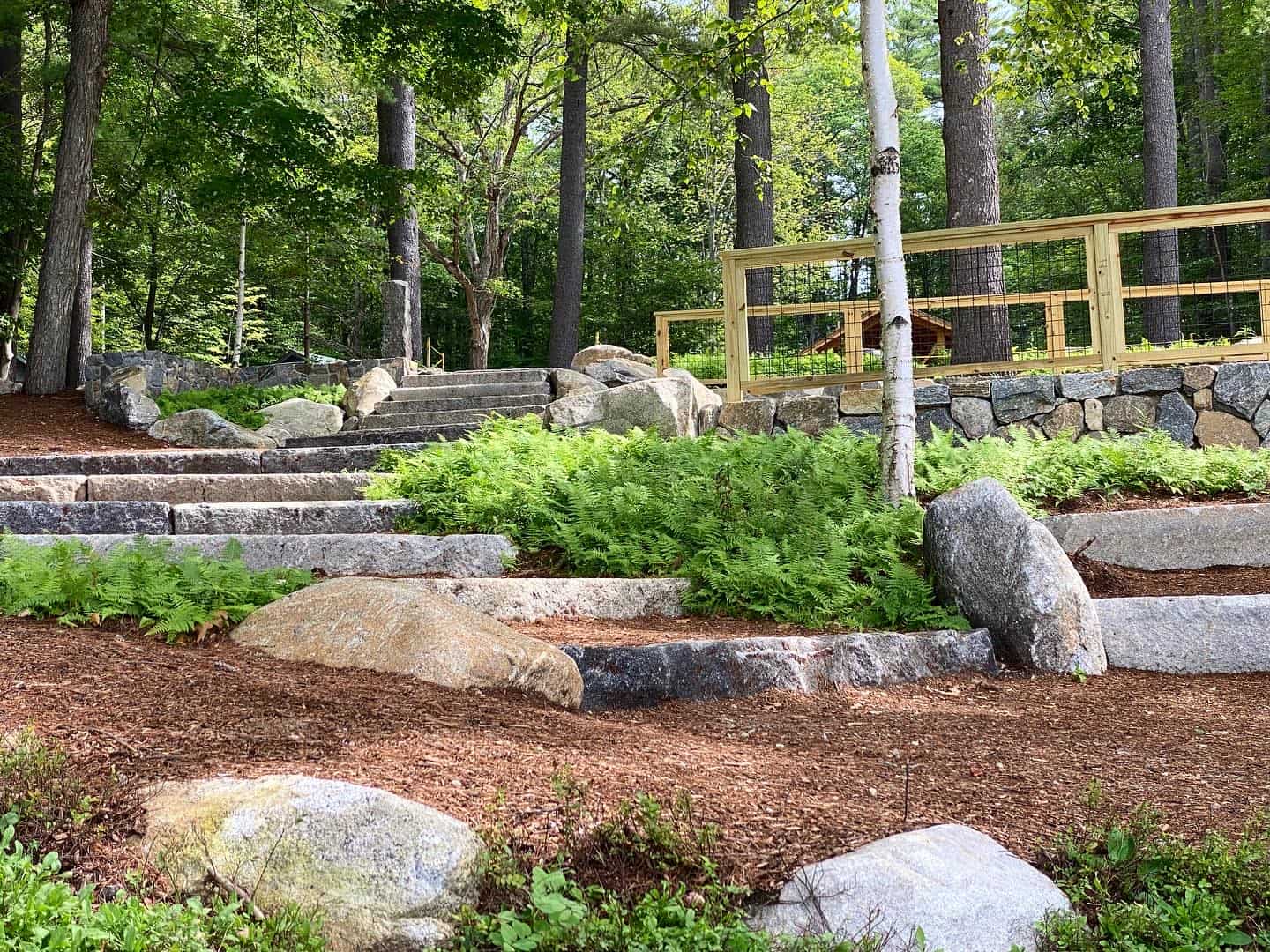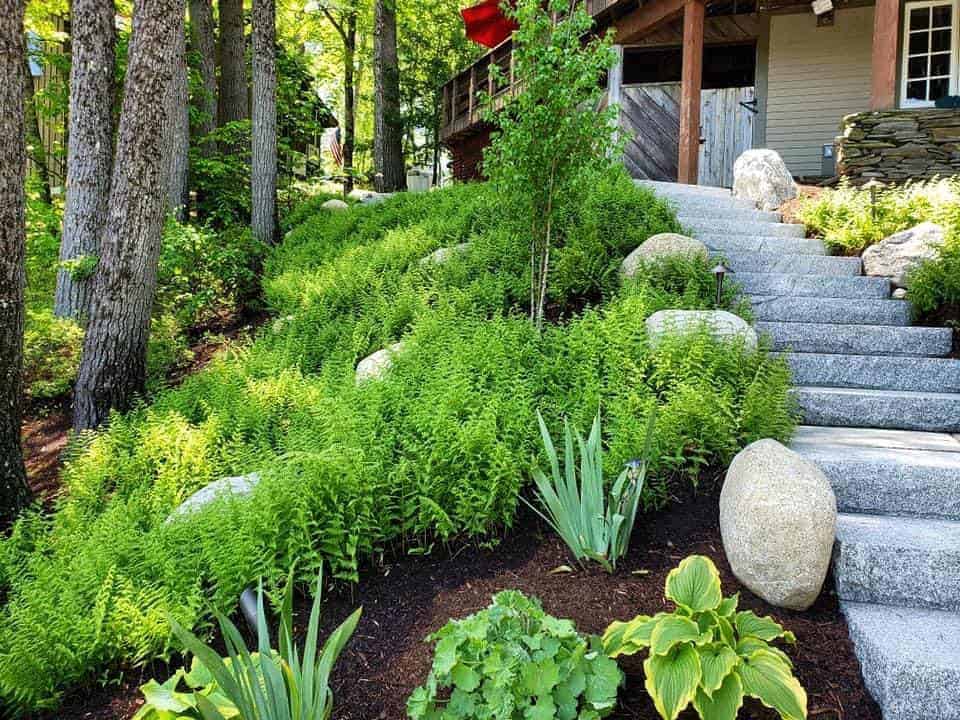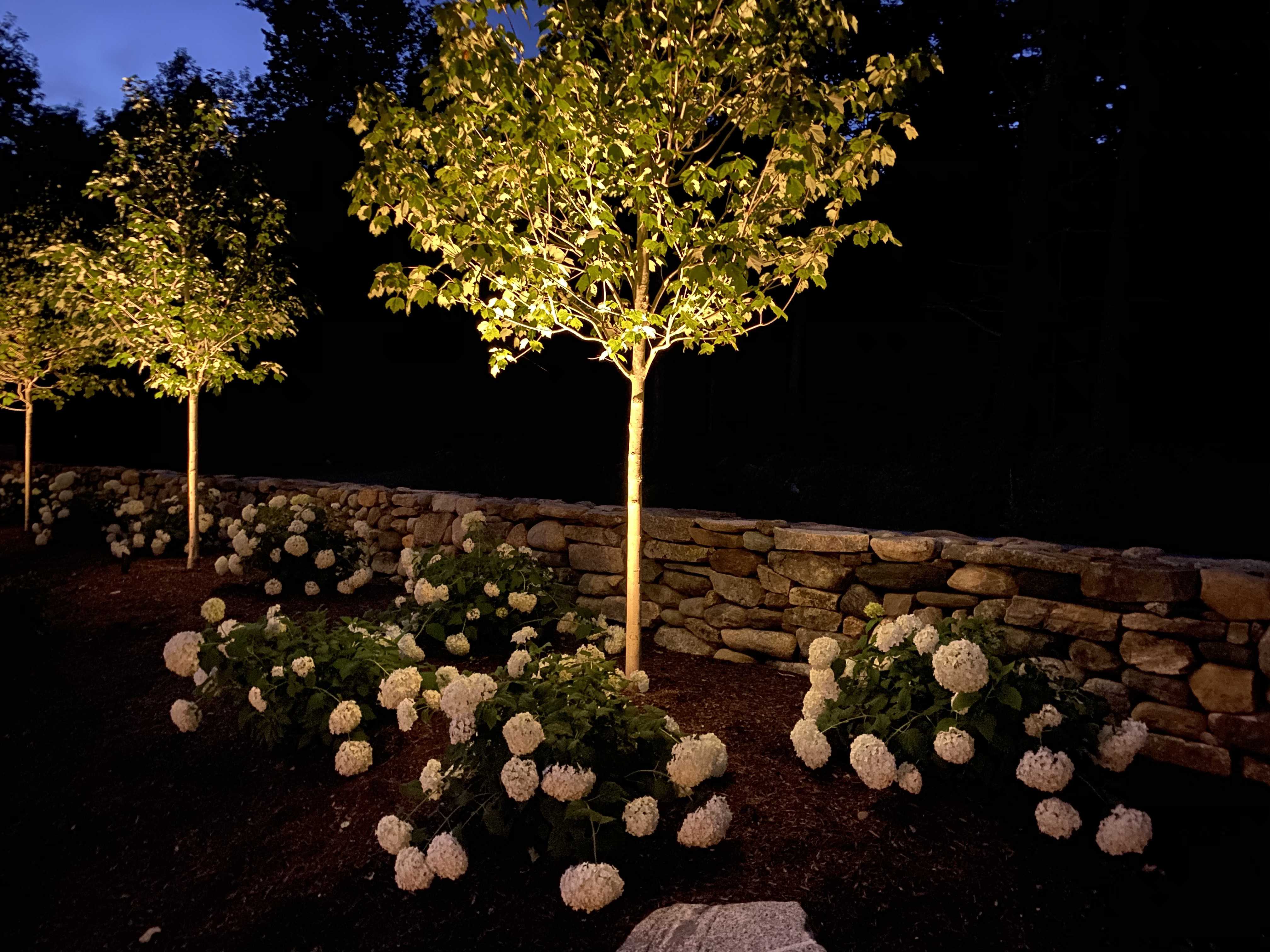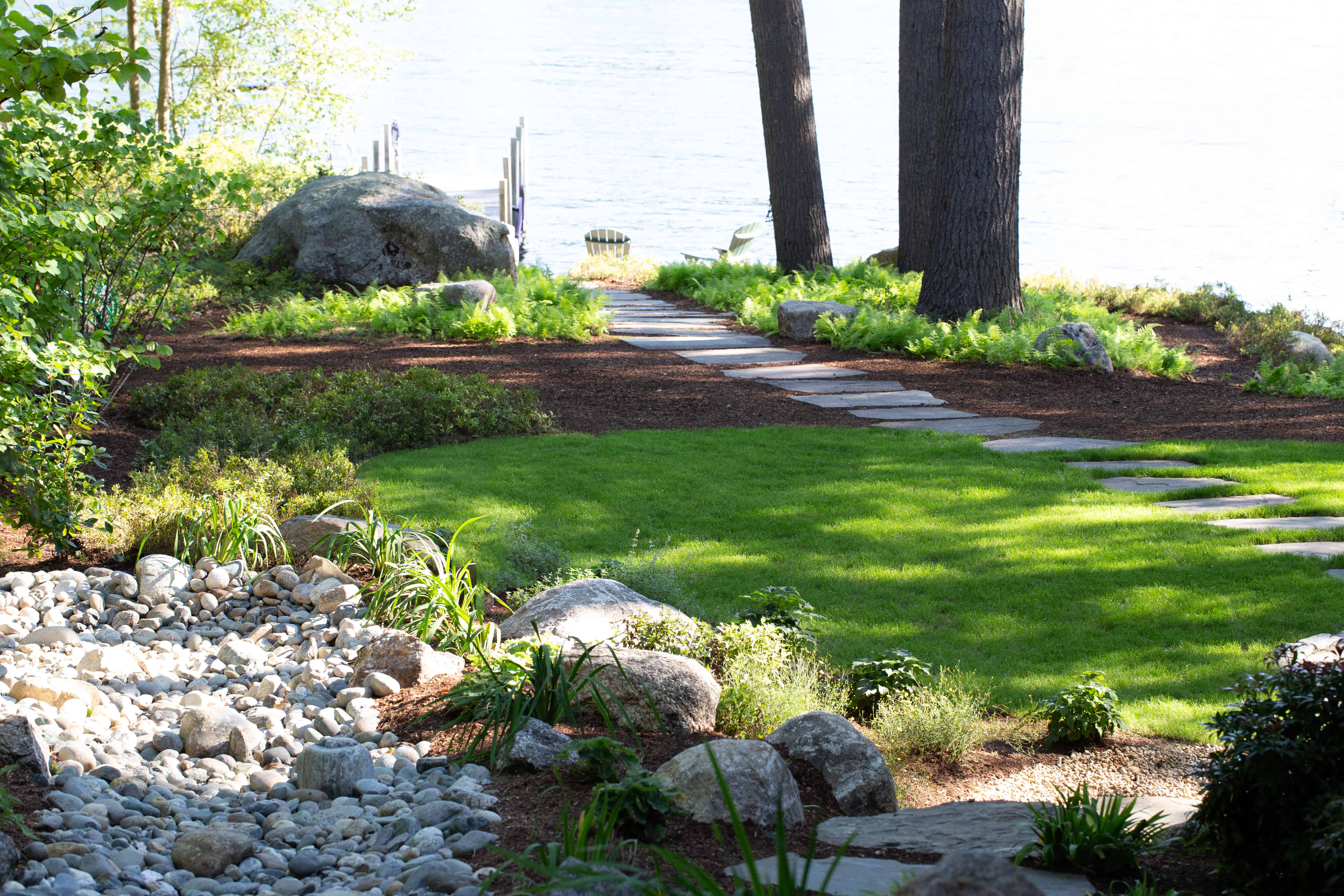
Native plants occur naturally and have meaningful effects and benefits to birds, butterflies, bees, and other wildlife. They are low maintenance, beautiful, require less water and fertilization, and help the climate by storing carbon dioxide, and providing vital habitat for wildlife. Utilizing native plants in your landscape means they are more likely to establish quickly and will be hardy. Some of our favorite natives that we incorporate into almost all of our landscape designs include:
Perennials
- Joe Pye Weed: These fast-growing flowers are favorites of butterflies, bees, and other pollinators. The tall, vanilla-scented wildflowers grow in leaf clusters several feet high, and in the summer, tiny mauve colored flowers appear on top of the leaf stems. They prefer an area that’s full sun to partial shade, and moist, well-drained soil. It’s best to plant these when there’s no chance of frost.
- New England Aster: This is a favorite here in New England and can be seen practically everywhere. This easily-recognizable flower grows to about five feet tall, and while the most popular variety has a medium purple flower with a dark yellow center, asters come in different shades of purple and even pink! This aster is drought-tolerant, deer resistant, and does well in all types of soil. It’s a late summer to early fall bloomer, and while it’s blooming, you may see the lower leaves drying up. But, don’t worry…your plants are not dying; this is normal.
- Blue Flag Iris: These lovely, classic irises are great additions to your garden, and do especially well around any water feature. They prefer soil that is acidic, rich, and moist, and to be located in an area that is full sun to part shade. These are early bloomers, and you can expect to see flowers from May to July. These are known to attract pollinators as well as hummingbirds.
- Sweetfern: This zero-maintenance plant has a sweet scent when crushed, and the leaves resemble little ferns, as its name implies. This shrub will spread itself out over the years, making clones of itself throughout your garden. It does well in poor, acidic soil, and is known to be a “nitrogen-fixer”.
- Hayscented Fern: This is a great fern if you have an area that needs some good coverage. These ferns prefer shade to part shade and grow from to eighteen to twenty-four inches in height. The fronds grow into a beautiful green color from the spring into the summer, and in the fall, turn a lovely yellow. When disturbed, the fern gives off an odor similar to fresh-cut hay.
Shrubs
- Low Bush Blueberry: This low bush is a great idea for an area where you need ground cover, or a nice border edge. The shrubs don’t grow very tall; they only get to a height of about two feet. They are very picky about their soil conditions, preferring sandy, well-drained and rich soil, and they like to be in full sun or partial shade. In the spring, they’ll feature small white flowers, the summer will bring some sweet edible berries (not the big ones you see in the supermarket, but still delicious and enjoyable. For those big commercial sized berries, you’ll need to plant the high bush blueberry, which is described below), and in the fall, the leaves will turn a very vibrant red. This shrub will add color to your garden for many seasons.
- High Bush Blueberry: If you’ve ever gone blueberry picking at a farm, you probably picked from a high bush blueberry. They are the most commercially-grown variety, and their berries are featured in most stores and farmers’ markets. These shrubs handle our cooler temperatures well, and they actually need some cold days in the winter to form berries in the spring; they’re perfect for New England. These bushes like moist soil but not standing water, so they should be planted on a slope for good drainage. They prefer full sun to partial shade (the more sun, the more blooms, more fruit, and more brightly colored fall leaves.) They do require regular watering.
- Clethra: Also known as summersweet or sweet pepperbush, this flowering shrub grows from three to eight feet tall, and features fragrant white, bottle-shaped flowers. This plant blooms in stages throughout the summer, and while it prefers wet soil (it’s usually found around the shoreline), it is drought-resistant once it has become established. It’s a favorite of pollinators like bees and butterflies.
- Winterberry Holly: This classic Christmas favorite is a perfect choice for adding winter color in your garden. While the shrub will drop its leaves in the fall, the red berries will continue to grow up until the spring. While the berries are a favorite feast for a variety of birds, they are toxic to people, dogs, and cats. The shrub can grow in both wet and dry soils, and in full sun, part shade, and full shade conditions. They grow from six to ten feet tall. You must plant a male and a female shrub of the same species in order to have the shrubs bloom at the same time and to have berries grow.
- Kalmia Latifolia: Commonly known as mountain laurel, you can see this flowering shrub in gardens all over New England. Its delicate pink and white bowl-shaped blooms appear in late spring and early summer, and once the blooms have passed, the dark green leaves will stay on the shrub throughout the winter months, adding a welcome patch of color. This shrub is a favorite of pollinators and does best in moderate to partial shade. It prefers to stay moist, so it’s best to keep your shrub watered well.
- Serviceberry: This plant can either be grown as a sizable shrub or small tree. In early spring, it blooms in pinkish white flowers, which then turn to delicious berries that look like blueberries but are a bit sweeter; they are ripe when the berry is a dark purple. In the fall, the leaves turn a beautiful shade of deep reddish orange. It prefers to be in full sun to light shade; the more sun, the better the flower and fruit production. It will tolerate many soil types. During the first year after you’ve planted, make sure to keep it well watered; after that, it will be pretty drought tolerant.

Trees
- Birch: Birch trees are a popular choice in many yards. Most everyone in New England is familiar with these tall, stately white bark trees. But birches come in many different varieties as well as the more known white ones. There are short shrub-type birches with reddish leaves that do well in a rain garden, a dwarf birch is a shrub good for ground cover and tolerates cold weather well. River birch are a tall pinkish-brown tree that “sheds” its bark throughout the season and features dark green leaves that turn a beautiful yellow in the fall, as well as many more! We’d love to discuss what variety would work best for you and your landscape.
- Sugar Maple: As New Englanders, we love our sugar maples. This tree is the primary source for maple syrup, a long-enjoyed tradition here in northern New England and a popular wood for furniture. This fast-growing tree needs room to grow, and prefers deep, well-drained loam or light clay. Once mature, this tree provides good shade in the summer, and spectacular foliage of bright red and orange in the fall.
- Red Maple: This is a tall tree. With heights reaching about 100 feet and a spreading root system, this is a tree that needs a lot of space in which to grow. This tree is easy growing, and not fussy—it grows well in both wet and dry soils, is fairly drought-tolerant, and does well in shady or sunny locations.
- Eastern Hemlock: This tall tree can grow up to 100 feet but can also be used as a hedge with proper, consistent pruning. It needs to have good drainage and be away from strong winds. The foliage of the eastern hemlock is fragrant and attracts both birds and butterflies, and will yield an abundance of pine cones. This tree is a slow grower, and needs direct sunlight and moist, well-drained soil. This tree will grow into a pyramid shape when not trimmed.
There are many options available to you to add year-round interest and color to your garden and landscape. We’d love to help you create a plan to maximize your space and achieve all of your landscape goals. Contact us to discuss your ideas or give us a call at 603.707.0630, and be sure to visit our Garden Center. We’ve got new plants coming in weekly, a wide selection of pottery, landscape aggregates, and annuals—all available for delivery! Come visit us Monday – Saturday: 8:00 A.M. – 5:00 P.M. Closed Sunday. Or give us a call at 603.677.9100 if you have any questions or are looking for something special.




 People are drawn to the beauty of New Hampshire for its mountains, wildlife, and its numerous pristine lakes and ponds. The Shoreland Water Quality Protection Act (SWQPA) was established to protect the natural resources and to oversee the management of shoreline properties. Protecting our natural resources and the quality of our public waters is the responsibility of all to ensure the health of the environment and the economy of NH.
People are drawn to the beauty of New Hampshire for its mountains, wildlife, and its numerous pristine lakes and ponds. The Shoreland Water Quality Protection Act (SWQPA) was established to protect the natural resources and to oversee the management of shoreline properties. Protecting our natural resources and the quality of our public waters is the responsibility of all to ensure the health of the environment and the economy of NH.